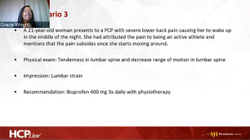Grace Wright. MD, PhD Reviews Challenging Cases of Rheumatic Diseases - Episode 2
Case Study 2: Rheumatoid Arthritis Patient Case Overview and Therapeutic Goals
Transcript:
Wright, MD: Case 2; let’s switch. You see his Crohn's Disease Activity Index [CDAI], so you know where we’re going with this one. This is a 48-year-old man initially presented to his primary care provider with noticeable stiffness in both hands, wrists, and ankles in the morning for the last 9 months. Why he waited 9 months is my first question. He has been treating himself with 800 mg 3 times daily of ibuprofen which initially worked but then stopped working. On exam when he comes to us, he’s got bilateral synovitis in his hands wrists and ankles, and he has a nodule of uncertain duration or type on his left elbow; we see he’s tender and swollen. He has a CDAI of 38 which is very active disease, whatever this disease is.
His labs are a little bit different. He’s got a CRP of 5.7 of 42, modest rheumatoid factor of 44, and a respectable cyclic citrullinated peptide antibody of 90. This is certainly not a super high number, and on his x-ray imaging those joint space narrowing with periarticular osteopenia, but no evidence of erosions based on x-ray. The recommendation for him at his first visit was to start methotrexate 10 mg per week oral and increase that to 15 mg after 4 weeks if he tolerates that, which is what he did, but 3 months later he is only minimally better; he has continuous stiffness, pain, and swelling in the wrists. His sedimentation rate is still up, and he complains of now being even more unproductive at work because of his joint pain.
The big problem I think that we have is, number 1, we’ve got all of these therapies, but we’re still being forced to step to methotrexate. If I put on my advocacy hat we need to be able to make the decisions that are right for the patient based on signs and not based on this sort of step board process where we lose time; he’s going to show up with erosions before we get to his first biologics.
Again, I just sort of put all the classes together here, and I remember when that first bag of Remicade was hung in New York City because it was in my office. That was just the other day, so patients no longer want them. We had patients come in with large rheumatoid nodules on the mitral valve. Plural nodules that were all rheumatoid. We don’t see that as much anymore because we’re not waiting around for 20 years to treat them, so here’s our plethora.
I won’t bore you with this, you are familiar with all of the names. We would’ve thought we were going to have forgot about it to the Janus kinase inhibitors, but they’ve had a delay in their approval process, so we will see where that ends up. This was the non-tumor necrosis factor [TNF] versus TNF treatment efficacy after the first treatment failure, so what happens when I switch? And whether we use a European League Against Rheumatism [EULAR] good or moderate response disease activity score 28 [DAS 28] response less than 3.2 for disease activity response or DAS 28 remission as a score.
You’ll see that the light blue and a dark blue keep the same Relative proportions. If I switch to a non-TNF within the class, and this was going from TNF to another TNF, we see that whether we’re looking at week 24 a week 52, no matter what the metric was whether it was a EULAR response, low disease activity response, or DAS 28 remission response, it was independent of that. These patients had a better response when they left class. However, the functional scores did not differ much, which is very interesting.
Transcript Edited for Clarity



